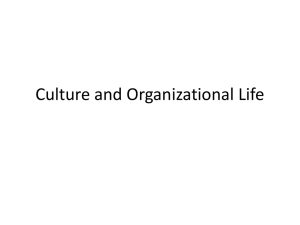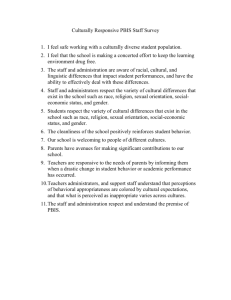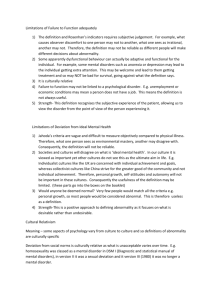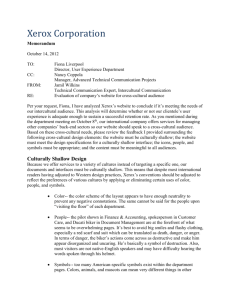Leading a gdt (2)
advertisement
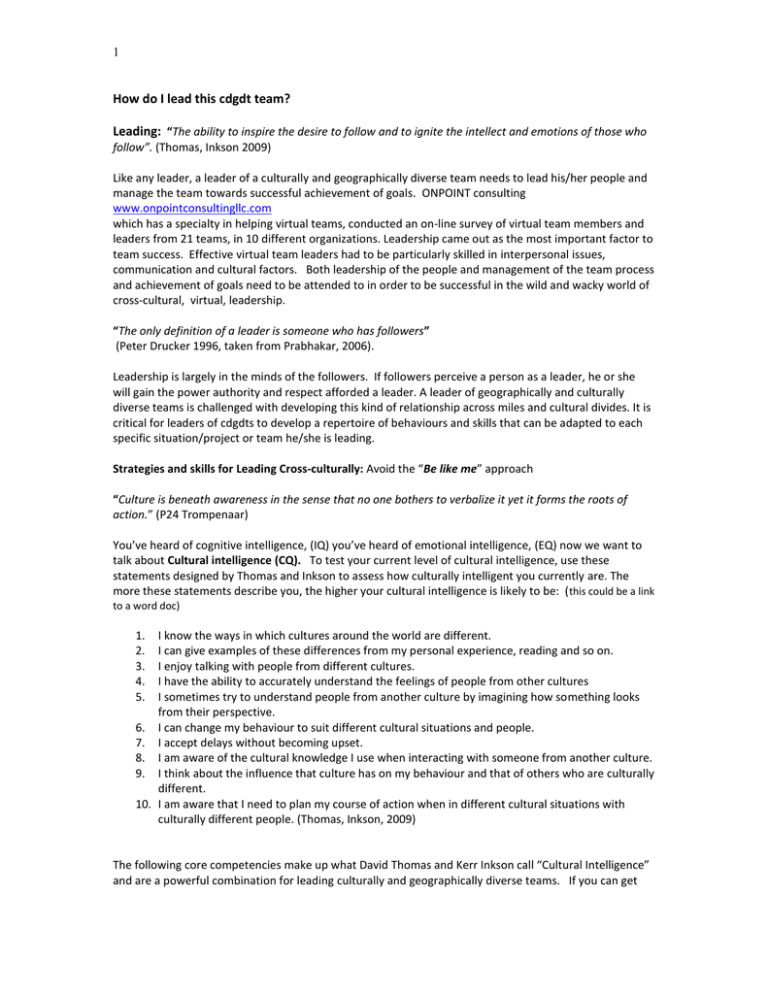
1 How do I lead this cdgdt team? Leading: “The ability to inspire the desire to follow and to ignite the intellect and emotions of those who follow”. (Thomas, Inkson 2009) Like any leader, a leader of a culturally and geographically diverse team needs to lead his/her people and manage the team towards successful achievement of goals. ONPOINT consulting www.onpointconsultingllc.com which has a specialty in helping virtual teams, conducted an on-line survey of virtual team members and leaders from 21 teams, in 10 different organizations. Leadership came out as the most important factor to team success. Effective virtual team leaders had to be particularly skilled in interpersonal issues, communication and cultural factors. Both leadership of the people and management of the team process and achievement of goals need to be attended to in order to be successful in the wild and wacky world of cross-cultural, virtual, leadership. “The only definition of a leader is someone who has followers” (Peter Drucker 1996, taken from Prabhakar, 2006). Leadership is largely in the minds of the followers. If followers perceive a person as a leader, he or she will gain the power authority and respect afforded a leader. A leader of geographically and culturally diverse teams is challenged with developing this kind of relationship across miles and cultural divides. It is critical for leaders of cdgdts to develop a repertoire of behaviours and skills that can be adapted to each specific situation/project or team he/she is leading. Strategies and skills for Leading Cross-culturally: Avoid the “Be like me” approach “Culture is beneath awareness in the sense that no one bothers to verbalize it yet it forms the roots of action.” (P24 Trompenaar) You’ve heard of cognitive intelligence, (IQ) you’ve heard of emotional intelligence, (EQ) now we want to talk about Cultural intelligence (CQ). To test your current level of cultural intelligence, use these statements designed by Thomas and Inkson to assess how culturally intelligent you currently are. The more these statements describe you, the higher your cultural intelligence is likely to be: ( this could be a link to a word doc) 1. 2. 3. 4. 5. I know the ways in which cultures around the world are different. I can give examples of these differences from my personal experience, reading and so on. I enjoy talking with people from different cultures. I have the ability to accurately understand the feelings of people from other cultures I sometimes try to understand people from another culture by imagining how something looks from their perspective. 6. I can change my behaviour to suit different cultural situations and people. 7. I accept delays without becoming upset. 8. I am aware of the cultural knowledge I use when interacting with someone from another culture. 9. I think about the influence that culture has on my behaviour and that of others who are culturally different. 10. I am aware that I need to plan my course of action when in different cultural situations with culturally different people. (Thomas, Inkson, 2009) The following core competencies make up what David Thomas and Kerr Inkson call “Cultural Intelligence” and are a powerful combination for leading culturally and geographically diverse teams. If you can get 2 these two right, you’ll be a long way towards successfully leading your team: Mindfulness This includes awareness of yourself and your cultural lens, and awareness of others and theirs. In cross cultural situations this means paying attention to the context you’re working within, while at the same time monitoring your own thoughts and feelings and regulating the knowledge and skills that you use. In other words, think before you speak! It is also being aware of your own assumptions, ideas and emotions and using all of your senses in perceiving situations with your team. With virtual teams, this may often be listening or noticing what what isn’t being said. Understand your own cultural worldview and preference for leadership style (e.g. are you a natural relationship oriented leader or more task focussed?) (Thomas, Inkson 2009) You also need to be open-minded and learn from & adopt other management styles from other cultures. Knowledge of the culture Get to know and understand the many cultural dimensions that influence how a person behaves. (for a model of cultural dimensions see chapter on Team Learning. Some things to notice for example are their values: are they more individualistic or group oriented? How do they attribute power, is it experience, age or simply by nature of role of leader? How do they communicate? Do they need to tell the story, or do they get straight to the facts? Are they relationship focussed, or do they focus on tasks? Get to know your own team and the cultural dimensions that influence them. Encourage them to learn about each other. Check out the ideas for learning about self and others in the Chapter on Team Learning. Adaptability to different situations/styles You need to vary your leadership to fit the characteristics and cultures of your individual team members, and the tasks to be accomplished. (Thomas, Inkson, 2009) Pay attention to the reactions of your team members to your leadership behaviours and adjust and course correct as necessary. Situational leadership, that is, adjusting your style to suit the individual is one way of successfully leading diverse teams. Encourage adaptability in your team (or hirefor it, if you have the choice) Other essential skills: Cross-cultural Communication Be careful of “going native’ - of trying to mimic cultural behaviours of your team members – it can be successful, or it can be seen as insincere, offensive, or downright ridiculous. If they know that Canadians usually start meetings on time, be on time, even if the culture of your team is a bit looser with showing up on time. Creating an environment of trust: Followers may have very different expectations of indigenous leaders than they have of you. It’s important that you learn what their expectations are, and demonstrate that you are open to adapting, and talk openly about what your style is. Encourage feedback, though some cultures may be uncomfortable giving feedback, (especially to a leader) or may give it so subtly that you miss it. Here are some tips for encouraging trust with your team, and amongst your team members (see Monalisa, M, Managing Global Design Teams, 2008 for more) Encourage face-to-face meetings sometimes – potentially at the beginning of projects or quarters Encourage prompt response to email inquiries Encourage teams to cooperate 3 Encourage the seeking of information or clarification when unclear Encourage phone conversations for opportunity to clarify and get to know each other in real time (this worked well for our team in creating this Handbook) Select a local team leader if the team is distant, but all in one country. Match the task to the technology. (see section on technology for help with this) Facilitating FUSION – or a “Third Culture” to get the job done collaboratively Wake up! Here’s another innovative strategy that has proven to be successful in leading cross-cultural, geographically diverse teams: You know that fusion cooking you‘ve had? On the Canadian Westcoast we have fusion Pacific cooking which blends our indigenous salmon with different Asian influences to create something delicious. Jeanne Brett, and Maddy Janssen (see an overview of their research here: http://insight.kellogg.northwestern.edu/index.php/Kellogg/article/cultural_intelligence_in_global_teams) developed a leadership approach for cross-cultural cdgdts that uses this idea. FUSION is based on two fundamental elements of collaboration: co-existence of differences and meaningful participation. It requires all team members to sublimate their culture to that of the team, creating a new cultural identity that is based on their common needs. Be aware of two risks associated with this strategy though that may stifle creativity: 1. Groupthink: Team members may submerge their cultural identities and hence their ability to think differently; 2. Consensus decision-making: An effort to include everyone in the decision-making might cause the team to function at the level of its least creative member. Some cultures may not want to work collaboratively with people on the same team who are older or more experienced than them. – they are status conscious and will defer to these people. A similar strategy for developing this kind of super ordinate culture has also been called creating a “third culture” (see Fontaine, 2006) If you have a choice in who is on your team, mixing teams so that there is cultural diversity as well as attending to strong cultural values such as power distance for e.g. may mitigate this issue. How do I manage this team? Managing: The activity of getting things done with the aid of people and other resources (ref: taken from wps.prenhall.com/wps/media/objects/213/218150/glossary.html); Not only do you need to inspire people to work together towards a common goal…you need to facilitate their ability to get things done! Performance: Expectations and Accountability It is critical to set clear expectations for cdgdts. You won’t be seeing the person toiling away at their desk, and you need to trust them to get the work done. Setting clear expectation for performance, and holding people accountable will make leading performance virtually a lot easier. Setting up collaborative and interdependent work tasks forces the team to work together and hold each other accountable. Just make sure that you’ve done your cross-cultural training, and your team has, before the team gets too far into their work. 4 Creating a Team Charter This can be a great way for the team to create the way they want to work together, and contribute to an environment of self-management. You might call this the team manifesto (See CT Team Manifesto in How will we work together) Balancing task orientation and relationship orientation Be mindful of the behaviours of your team members that indicate a task or relationship orientation – this can be specific to different cultures. Everyone tends to have a preference and for some, they won’t be ready to get down to business until they’ve discussed the weather, the health of their families etc. Some leaders set up a virtual, on-line water-cooler to give their team a place to go to get to know each other and chat about non-work issues. Delegation or self-management (see also section on Performance expectation and accountability) While direct leadership strategies are possible in conventional teams, members of virtual teams might be managed more effectively by empowerment and by delegating managerial functions to the members However, team members only accept and fulfill these functions when they are motivated and identify with the team and its goals, which, as we’ve said, more difficult to achieve in virtual teams. This changes the role of a team manager from traditional controlling into more coaching and relationship management. Organizing across time zones Encourage overlapping work hours if possible. This allows team members to communicate in real time occasionally and will make the planning of conference calls, video-conferences etc more palatable and effective. Also, rotate the times that you have virtual meetings so that the guy in India isn’t always the one getting up at 4am. In summary, be mindful, learn about cultures, be a leader people want to follow, set up tasks, roles and responsibilities clearly…and delegate.
